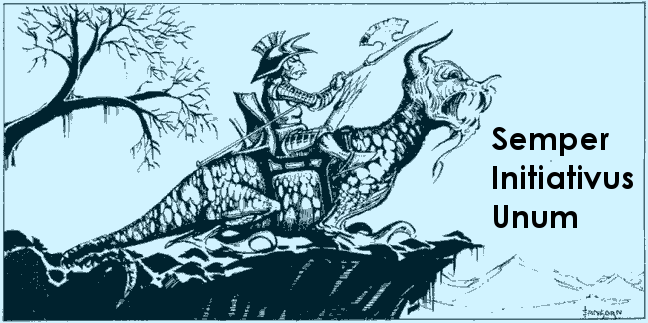It is hard to deny a certain old school appeal to David C. Sutherland III's orcs. When you describe pig-men, you know these are orcs and their job is to try to stab PCs, and get stabbed in return. There's no horror to them, no moral equivalences, it's a tried and true foe that does perfectly well to say "we are in D&D fantasy."
 OD&D simply describes them as tribal creatures which hate daylight like goblins do, spending more time worrying about the kind of fortifications of their lair than what the things actually look like - one of the more refreshing aspects of the OD&D books when you are interested in re-interpreting monsters. They are merely expected to live in tribes that act as the foils of human civilization; their particular organization usually revolves around some more powerful opponent. An individual orc is exactly at the point to go toe-to-toe with an average PC of first level; all this tends to make them humanity's dark mirror. If you go back to the actual play report from a convention game run by Dave Arneson that I had put up several years back, orcs are assumed to be encountered in masses in the early dungeons.
OD&D simply describes them as tribal creatures which hate daylight like goblins do, spending more time worrying about the kind of fortifications of their lair than what the things actually look like - one of the more refreshing aspects of the OD&D books when you are interested in re-interpreting monsters. They are merely expected to live in tribes that act as the foils of human civilization; their particular organization usually revolves around some more powerful opponent. An individual orc is exactly at the point to go toe-to-toe with an average PC of first level; all this tends to make them humanity's dark mirror. If you go back to the actual play report from a convention game run by Dave Arneson that I had put up several years back, orcs are assumed to be encountered in masses in the early dungeons.My inclination is to run with the bestial undercurrent of the orc. If you think about "beast-men" in roleplaying, several are obvious. The classic kobold is a dog-man, the gnoll is a hyena-man, the minotaur is a cow-man, the rakshasa is a tiger-man. Sutherland's orcs are pig-men, and I think that's fine - if it's one tribe of orcs. This feeds into something I've been pondering for a while, about a question of diverse and interesting creatures that resemble humans with various animal heads.
In keeping with the loose inspiration of Orcus, a human with a goat head seems to give the almost Satanic presence that is demanded by the name of an orc. Just the slit-shaped eyes should seem freakish. A donkey-man brings home the idea that this is a beastial creature (and puts us in mind of fairy tales and A Midsummer Night's Dream), and perhaps allows a bit more variation; is this a more "neutral" tribe of orcs, but one that takes on the stubbornness and ill temper of the creatures they resemble.
This is a question of "freshening up" monsters that I think is important to find a certain balance. With the creature list from Monsters & Treasure, which I think provides the majority of the "true" classic D&D monsters, I think there's a need to balance between what is familiar (sometimes to the point of cliché) and novelty merely for the sake of novelty. A deeply tribal nemesis like the orc is a perfect thing to play with: your "normal" pig-faced orcs are one tribe among many, and there are weirder orcs. Particularly this allows the freedom to really play with different tropes. The pig-faced tribe is your standard "raid and retreat" sort of orc, while the goat-headed orcs are devout Satan worshippers and perform vile rituals, and the donkey-headed tribe are open to negotiation but no friends of humanity.
Other types of orcs open for interpretation might base themselves on more or less sinister or vicious animals. I think there's something to really distinguish some of your orcs while keeping the good old familiar ones around.

Don't forget Blake.
ReplyDeletehttp://en.wikipedia.org/wiki/Orc_%28Blake%29
I had some fun with orcs here, making them demonic footsoldiers.
http://fictivefantasies.wordpress.com/2012/08/20/orcs-of-the-iron-principalities/
I always liked Moorcock's chaos beastmen. WHen Elric is traveling in the Shadow Plane he meets the pig men who only say 'PIG!' and the multi-headed snakeman who whispers 's-s-s-s-s-snake!' Extend that and you've accounted for a good quarter of the creatures in the MM and FF!
ReplyDeleteYeah, beastmen were something I was working on years ago, but it really fell apart for me. I like the idea that orcs can stand in for multiple types, and I may expand this into a full-on article for the third issue of Dungeon Crawl (of course that means getting the second out...).
DeleteI was just reading the old Warhammer Forces of Fantasy (Games Workshop 1983). Here's what it said in the orc description:
ReplyDelete"This debasing of fighting Orc stock, together with tribal bigotry and fragmentation has resulted in the appearance of several distinguishable Orc races. Of special note are the famous Pig Faced Orcs who enjoyed fame and supremacy in former times, but who are now, sadly, hardly ever seen at all."
Funny to see nostalgia for pig faced orcs in 1983 especially from the company that would later reshape our modern image of orcs as greenskins.
This is great, keep doing this!
ReplyDeleteI feel obliged to mention "orcneas" -Anglo-Saxon for death-corpse or hel-deofol (hell-devil). Grendel is described with this moniker among others
I had a go a long time back at converting RQ's Broo to AD&D, speaking of goat-headed humanoids. It's over on DF if you are interested:
ReplyDeletehttp://www.dragonsfoot.org/forums/viewtopic.php?f=1&t=27447&hilit=broo